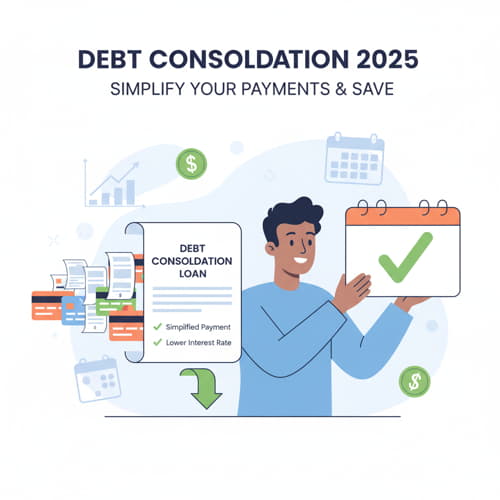Debt Consolidation Loan 2025 – Simplify Your Finances
Debt Consolidation Loan 2025 – Simplify Your Finances: Your Strategy for a Lighter Debt Load in 2026
Introduction: The Path to Financial Simplicity (2025 & Planning for 2026)
For millions of US consumers, juggling multiple high-interest debts—credit cards, medical bills, or old personal loans—creates enormous financial stress and complexity. A Debt Consolidation Loan (DCL) offers a powerful solution: taking out one single, large loan to pay off all smaller, existing debts. This effectively simplifies your finances from several payments, due dates, and varying high interest rates into a single, predictable monthly payment with a fixed term and a potentially lower overall interest rate.
In 2025, the rising cost of living and continued interest rate volatility make debt simplification more urgent than ever. Looking ahead to 2026, experts predict a continued focus on credit health and careful budgeting. Therefore, a Debt Consolidation Loan used strategically today can serve as the foundation for a much lighter financial burden next year. This comprehensive guide will detail the mechanics of a DCL, explore the two main types, provide the crucial break-even analysis, and outline a strategic approach to debt freedom for 2026.
## The Mechanics: How Debt Consolidation Simplifies Your Life
The core benefit of a Debt Consolidation Loan is a dramatic reduction in complexity and, ideally, cost.
- Single Payment: Instead of tracking five different bills, you have just one fixed monthly payment to one lender. This significantly reduces the risk of missing a payment.
- Fixed Term: The new loan has a set end date (e.g., 3 to 7 years). Unlike credit card debt, which can be perpetually revolving, a DCL provides a clear finish line to your debt.
- Lower APR: If your credit score has improved since you took out the original high-interest debts (often credit cards with 20%+ APRs), you can likely secure a DCL with a much lower Annual Percentage Rate (APR), saving you thousands in interest over the loan term.
The Golden Rule: A DCL is only financially worthwhile if the new loan’s APR is significantly lower than the average APR of the debt you are consolidating.
## Two Strategic Types of Consolidation Loans in 2025
The US market offers two primary routes for debt consolidation, differentiated by collateral and risk:
1. Unsecured Personal Loan (The Primary Choice)
- Mechanics: This loan is based entirely on your creditworthiness (FICO score and DTI), requiring no collateral. The funds are disbursed as a lump sum to pay off your credit cards and other debts.
- Pros: Low risk to your assets. Can be quickly secured from online lenders.
- Cons: Interest rates are higher than secured options (typically 7% to 35.99%) and require a Good to Excellent FICO score (670+) to secure the best rates.
2. Home Equity Loan or HELOC (Secured Consolidation)
- Mechanics: You use the equity in your home as collateral. This allows you to borrow a much larger amount at the lowest possible interest rate (often single digits).
- Pros: The lowest APR available in the market, maximizing interest savings. Crucially, the interest may be tax-deductible if the funds are used for home improvements (consult a tax advisor).
- Cons: Extreme Risk. Since your home is collateral, defaulting on the loan means you risk foreclosure and losing your property. Therefore, this option demands absolute repayment certainty.
## The Crucial Step: Calculating the Break-Even Point
Consolidation loans come with Origination Fees (1% to 8%) and other closing costs. You must determine if the interest savings outweigh these fees.
Example Scenario:
- New Loan Fees: $1,500
- Monthly Savings: $100 (e.g., old payments total $800, new DCL payment is $700)
- Breakeven Point: $1,500 / $100 = 15 months
Rule: If you plan to pay off the DCL within the break-even period, the consolidation is not worth the cost. It’s a strategic move for long-term debt reduction (typically 3-7 years).
## Strategy for 2026: Consolidation as a Credit Builder
A Debt Consolidation Loan can be a powerful tool for improving your financial standing in 2026:
- Improves Credit Utilization: When the DCL pays off your credit cards, those card balances drop to zero. Since Credit Utilization (the amount you owe vs. your total credit limit) accounts for 30% of your FICO score, dropping this ratio instantly boosts your score, setting you up for better rates on all future credit in 2026.
- Credit Mix: Adding a personal installment loan (the DCL) to your credit file (which might previously have only had revolving debt like credit cards) diversifies your Credit Mix (10% of your FICO score), further supporting score growth into 2026.
- Perfect Payment History: A single, lower payment is easier to manage. Committing to flawless, on-time payment history (35% of your FICO score) for the entire DCL term ensures you enter 2026 with a robust credit profile.
## 2026 Financial Forecast & Action Steps
As the market evolves, specific actions in 2025 will define your financial success in 2026:



